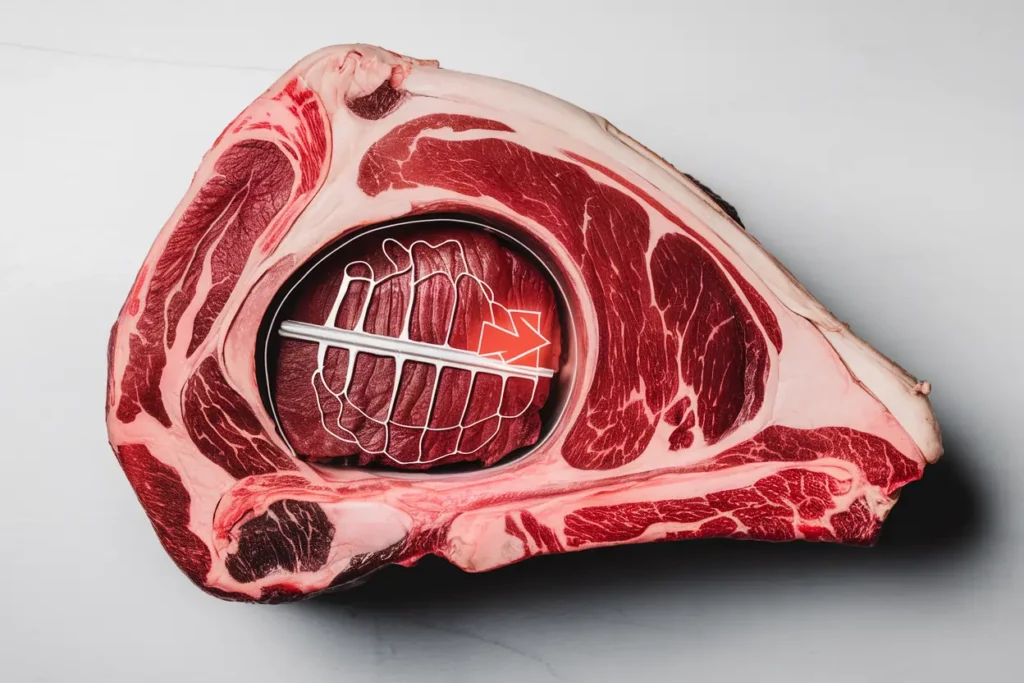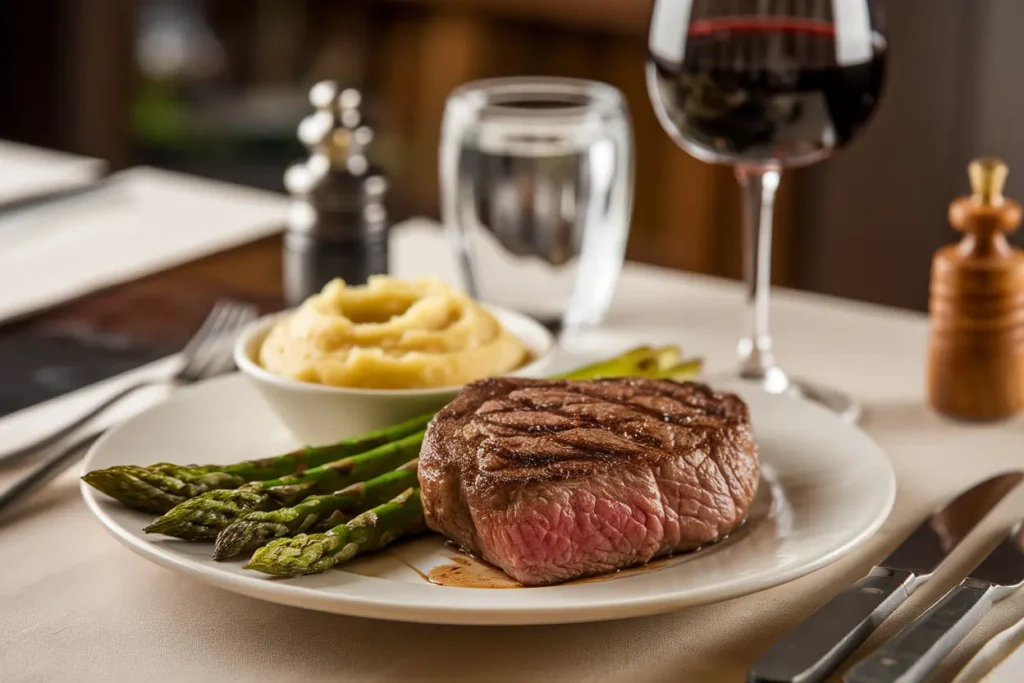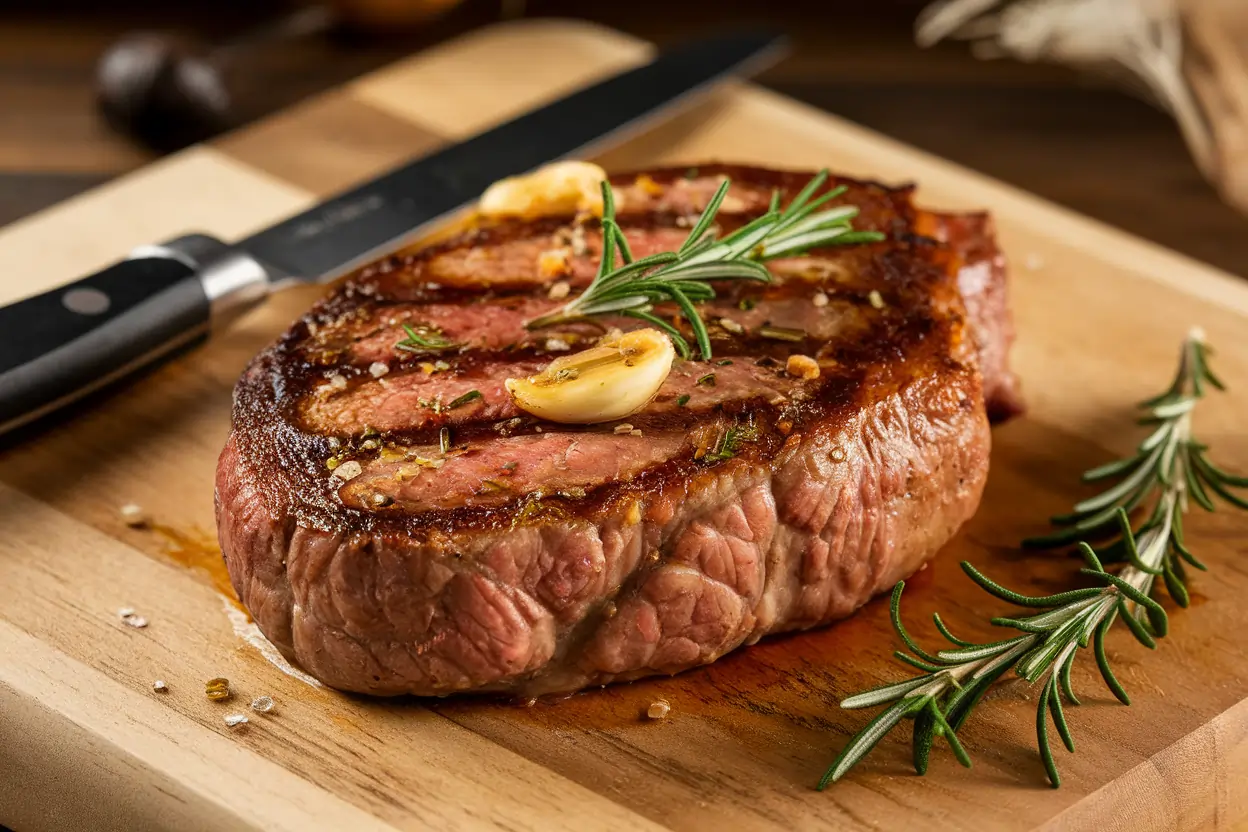Introduction to Spinalis Steak
If you’ve ever enjoyed the tender, buttery, and intensely flavorful cap of a ribeye, chances are you’ve had a taste of the legendary spinalis steak. But what exactly is it? Why is it celebrated by chefs and foodies alike? Stick with me, and I’ll walk you through everything you need to know about this luxurious cut of beef. Trust me, by the end, you’ll be craving a bite! 🍖
Table of Contents
What Makes It a Must-Try?
Let’s cut to the chase (pun intended). What sets spinalis steak apart from other beef cuts? For starters, it’s often referred to as the “crown jewel” of steaks because it combines the perfect marbling, rich beefy flavor, and melt-in-your-mouth texture. Think of it as the VIP section of a ribeye. It’s that little piece you savor the most before moving on to the rest of the steak.
But here’s the kicker: the spinalis steak isn’t always easy to find. It’s rare, exclusive, and highly sought-after, making it a true delicacy. When you spot it at your butcher’s or on a menu, grab it like it’s the last slice of pizza at a party!
A Brief History of This Gourmet Delight
Where did this gourmet cut come from, and how did it earn its star status? While there’s no dramatic origin story involving kings or ancient recipes, the rise of spinalis steak can be credited to chefs who started spotlighting ribeye caps as standalone cuts.
Once considered a bonus part of the ribeye, the spinalis gained fame as people realized its luxurious qualities. It’s proof that sometimes the best things are hiding in plain sight—like that one genius in a group project who quietly does all the work. 🤓
How It Stands Out from Other Beef Cuts
Comparing Its Flavor to Popular Steaks
Let’s break it down. The spinalis steak is part of the ribeye, so it shares its signature marbling and flavor. But unlike the rest of the ribeye, it’s more tender and packs an even punchier beef taste. Think of it as the diva of the steak world—extra fabulous and unapologetically bold.
Now, filet mignon is tender but lacks the intense flavor of spinalis steak. Sirloin, on the other hand, is leaner and chewier. If filet mignon is like a smooth jazz tune and sirloin is a rock ballad, spinalis steak is a full-on symphony! 🎶
Why Texture Matters
Imagine cutting into a piece of meat so tender that your knife glides through like butter. Now add a flavor explosion that’s rich, savory, and slightly nutty. That’s spinalis steak in a nutshell. Its marbling creates an almost creamy texture that makes every bite feel indulgent.
Let’s just say if steaks were high school cliques, spinalis would be the popular kid everyone secretly admires.
Origins of This Luxurious Cut
Anatomy of the Ribeye Cap

The spinalis steak comes from the cap of the ribeye, specifically the muscle called the spinalis dorsi. Picture a ribeye steak—it has that central “eye” of meat surrounded by a luscious outer layer. That outer layer? Yep, that’s the spinalis. It’s like finding the cherry on top of a sundae, but way better (and meatier). 🍒
The Butcher’s Approach
Butchering the spinalis steak is an art form. It’s not something you can just hack away at. Skilled butchers carefully separate the cap from the ribeye, ensuring the cut retains its integrity and marbling. This precision is part of why spinalis steak is rare and highly prized.
Think of it like carving out the gooey center of a cinnamon roll—it takes patience, skill, and a deep appreciation for the good stuff.
Choosing the Perfect Cut
Tips for Picking the Best Quality
Shopping for spinalis steak? Keep your eyes peeled for the following:
- Marbling: The more, the better. Those thin white streaks of fat mean flavor heaven.
- Freshness: Look for bright red meat with no grayish tinge.
- Thickness: A thicker cut will cook more evenly and retain juiciness.
Grass-Fed or Grain-Fed: Which is Your Style?
Grass-fed spinalis steak tends to have a slightly leaner profile with a more earthy flavor, while grain-fed is fattier and richer. It’s like choosing between a smooth espresso and a creamy latte—both are amazing; it just depends on your taste.
Understanding USDA Grades for Spinalis Steak
When buying, you’ll likely see USDA grades like Prime, Choice, or Select. Prime has the best marbling and tenderness, making it perfect for spinalis steak. Choice is great too, but Select might lack the luxurious texture you’re after.
💡 Pro Tip: Always go for Prime if your budget allows—it’s worth the splurge!
Nutrition Facts of Spinalis Steak
| Nutrient | Amount (Per 6 oz) |
|---|---|
| Calories | 450 |
| Protein | 36g |
| Total Fat | 35g |
| Saturated Fat | 14g |
| Cholesterol | 130mg |
| Iron | 3.2mg |
| Vitamin B12 | 2.5mcg |
👉 While spinalis steak isn’t exactly diet food, it’s packed with protein and iron, making it a hearty and nutritious treat when enjoyed in moderation.
Cooking Techniques to Master
Preparing Spinalis Steak for Cooking
Before you even think about turning on the stove or firing up the grill, there’s some prep work to do. First, bring your steak to room temperature—cold meat doesn’t cook evenly. Next, pat it dry with paper towels to ensure a nice crust. Sprinkle generously with salt and pepper; keep it simple to let the natural flavors shine.
💡 Pro Tip: Want extra flavor? Marinate the steak in olive oil, garlic, and rosemary for a couple of hours. It’s like giving your steak a spa day! 🛀
Grill It Like a Pro
Grilling is one of the best ways to cook spinalis steak because it enhances its smoky, beefy flavor. Here’s how you do it:
- Preheat Your Grill: Get it nice and hot—around 400°F (204°C).
- Sear the Steak: Place it directly over the flames for 2-3 minutes per side.
- Move to Indirect Heat: Shift the steak to a cooler part of the grill to finish cooking.
- Check the Temperature: Use a meat thermometer. For medium-rare, aim for 130°F (54°C).
- Rest the Steak: Let it sit for 5-10 minutes before slicing.
🔥 Fun Fact: That sizzle when the steak hits the grill? It’s the sound of deliciousness being unlocked.
Pan-Seared Perfection: Cooking Spinalis Steak Indoors
No grill? No problem. A cast-iron skillet can work wonders. Here’s what to do:
- Heat the skillet until it’s smoking hot.
- Add a high-smoke-point oil, like avocado or canola oil.
- Sear the steak for 2-3 minutes on each side.
- Lower the heat, add a knob of butter, and baste the steak for another 2 minutes.
💡 Chef’s Tip: Add smashed garlic cloves and a sprig of thyme to the butter for an aromatic twist.
Sous Vide Spinalis Steak: A Modern Cooking Method
Sous vide might sound fancy, but it’s just a surefire way to cook your steak to perfection.
- Season the Steak: Add salt, pepper, and any other herbs you like.
- Vacuum Seal It: Use a sous vide bag and a vacuum sealer.
- Cook It Low and Slow: Set your sous vide machine to 129°F (54°C) for medium-rare and cook for 1-2 hours.
- Finish with a Sear: After sous vide, quickly sear the steak in a hot skillet to develop that mouthwatering crust.
💬 Why Sous Vide? It’s like the cheat code for steak—perfect doneness every single time.
Resting and Slicing Spinalis Steak Properly
One of the biggest mistakes people make is skipping the resting phase. Don’t do it! Resting lets the juices redistribute, keeping your steak moist and tender.
When slicing, always cut against the grain. This shortens the muscle fibers and makes each bite feel like it’s melting in your mouth.
Pairing Spinalis Steak with Sides and Sauces

Best Side Dishes for Spinalis Steak
What’s a steak without its trusty sidekicks? Here are some fan favorites:
- Garlic Mashed Potatoes: Creamy, buttery, and the perfect foil to a rich steak. 🥔
- Grilled Asparagus: Adds a hint of freshness and crunch.
- Mac and Cheese: Because sometimes, indulgence deserves a side of indulgence. 🧀
Top Sauces to Complement Spinalis Steak
A good sauce can take your spinalis steak to the next level. Here are the MVPs:
- Chimichurri: A zesty mix of parsley, garlic, and olive oil.
- Red Wine Reduction: Deep, rich, and elegant.
- Garlic Butter: Simple but heavenly—drizzle it over the steak for instant magic.
Common Problems When Cooking Spinalis Steak and How to Solve Them
Avoiding Overcooking or Undercooking
Nobody wants a steak that’s too dry or too rare. Always use a meat thermometer to take the guesswork out. And remember: the steak will continue to cook a bit while resting, so pull it off the heat slightly early.
Preventing Dryness in Spinalis Steak
Dry steak? That’s a heartbreak we can prevent. Make sure not to overcook, and don’t forget to baste with butter or oil during cooking.
Solving Uneven Cooking Issues
If your steak cooks unevenly, the problem might be the pan or grill heat. Make sure your surface is evenly heated, and flip the steak regularly for consistent cooking.
Where to Buy Spinalis Steak: Online and Local Options
Finding Specialty Butchers or Stores
If you’re on the hunt for spinalis steak, your best bet is a specialty butcher shop. Why? Because this cut isn’t something you’ll typically find at a standard grocery store. When you visit a butcher, don’t hesitate to ask if they can custom-cut the ribeye cap for you. They’re often happy to help you find the perfect piece.
Another tip? Local farmer’s markets sometimes carry this cut, especially if the vendor specializes in premium beef. It’s like finding a hidden gem in a treasure chest! 🪙
Online Retailers for Spinalis Steak
Can’t find spinalis steak locally? No worries—you can buy it online. Websites specializing in high-quality meats often carry this cut. Some well-known retailers ship directly to your doorstep, vacuum-sealed and ready to cook.
💻 Pro Tip: Look for sellers with good reviews and clear information about their sourcing. Transparency is key when buying premium cuts online.
Spinalis Steak Recipes for Every Occasion
Simple Weeknight Spinalis Steak Recipe
Sometimes, you just want a quick and easy dinner that still feels luxurious. This recipe keeps things simple while letting the natural flavor of the spinalis steak shine.
Ingredients:
| Ingredient | Quantity |
|---|---|
| Spinalis Steak | 2 (6-8 oz each) |
| Salt | To taste |
| Black Pepper | To taste |
| Olive Oil | 2 tbsp |
| Garlic Cloves (crushed) | 3 |
| Butter | 2 tbsp |
| Fresh Thyme | 2 sprigs |
Instructions:
- Season both sides of the steak with salt and pepper.
- Heat olive oil in a cast-iron skillet over medium-high heat until shimmering.
- Sear the steak for 2-3 minutes per side.
- Reduce heat to medium, add butter, garlic, and thyme. Baste the steak with the melted butter for another 2 minutes.
- Remove from heat and let rest for 5 minutes before serving.
Gourmet Spinalis Steak for Special Events
Hosting a dinner party or celebrating a special occasion? This recipe elevates your spinalis steak with a red wine reduction sauce.
Ingredients:
| Ingredient | Quantity |
|---|---|
| Spinalis Steak | 4 (6-8 oz each) |
| Salt | To taste |
| Black Pepper | To taste |
| Red Wine | 1 cup |
| Beef Broth | 1 cup |
| Shallots (minced) | 2 |
| Butter | 3 tbsp |
| Thyme | 1 sprig |
Instructions:
- Season steaks with salt and pepper and sear in a hot skillet. Set aside to rest.
- In the same skillet, sauté shallots until golden.
- Deglaze the pan with red wine, scraping up any browned bits.
- Add beef broth and thyme, then simmer until reduced by half.
- Stir in butter for a velvety finish, then drizzle over your steak.
🍷 Chef’s Tip: Serve with roasted vegetables and mashed potatoes for a restaurant-quality meal.
FAQs About Spinalis Steak
What Makes Spinalis Steak So Expensive?
It’s all about rarity and quality. Spinalis steak is a small portion of the ribeye, so there’s only a limited amount available per cow. Pair that with its incredible flavor and tenderness, and you’ve got a premium product that commands a higher price.
How Do I Know If I’ve Cooked It Correctly?
A perfectly cooked spinalis steak will have a golden-brown crust and a juicy, tender interior. Use a meat thermometer to check the internal temperature—130°F (54°C) for medium-rare is the sweet spot.
If you’re a fan of rich, well-marbled cuts, you might already love the Zabuton steak for its buttery texture and deep flavor. But another cut that stands out for its tenderness and intense beefy taste is the Spinalis steak. Often considered the most flavorful part of a ribeye, the Spinalis is a must-try for steak lovers who appreciate high-quality, gourmet cuts. If you’re curious about how this cut compares to others, check out our guide on Rib Cap vs. Spinalis, where we break down their differences and best cooking methods. Looking for more underrated steak options? The Bavette steak is another delicious choice known for its versatility and bold beefy flavor
Conclusion: Why Spinalis Steak is Worth the Hype
So, is spinalis steak worth the hype? Absolutely! It’s the kind of steak that transforms a regular dinner into an unforgettable experience. With its rich marbling, tender texture, and unbeatable flavor, it’s a cut that every steak lover should try at least once. Whether you grill it, pan-sear it, or go the sous vide route, this steak is a guaranteed showstopper.
So, what are you waiting for? Go ahead, treat yourself to the ultimate steak experience—you deserve it! 🍽️.

